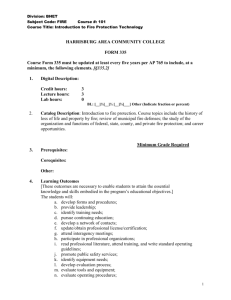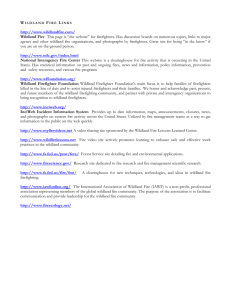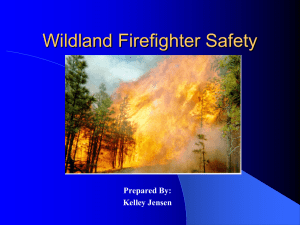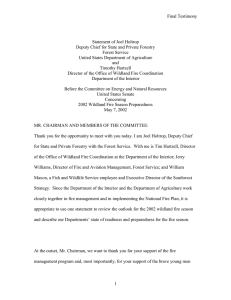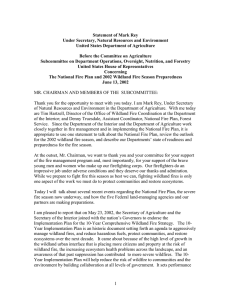Statement of Sally Collins Associate Chief, Forest Service
advertisement
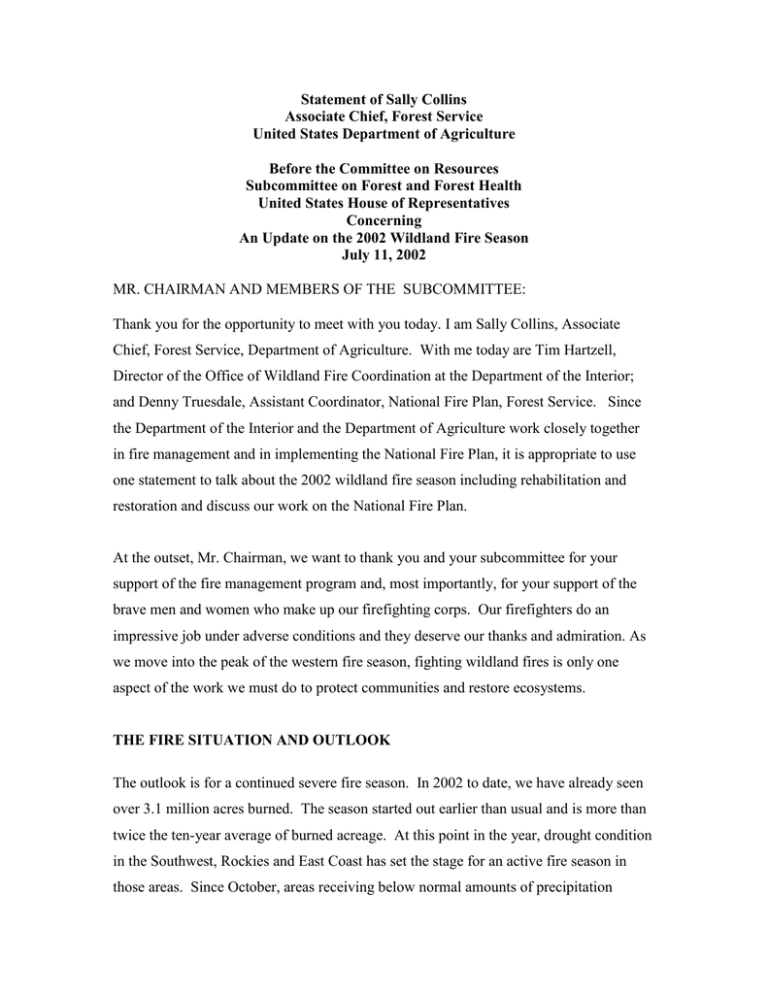
Statement of Sally Collins Associate Chief, Forest Service United States Department of Agriculture Before the Committee on Resources Subcommittee on Forest and Forest Health United States House of Representatives Concerning An Update on the 2002 Wildland Fire Season July 11, 2002 MR. CHAIRMAN AND MEMBERS OF THE SUBCOMMITTEE: Thank you for the opportunity to meet with you today. I am Sally Collins, Associate Chief, Forest Service, Department of Agriculture. With me today are Tim Hartzell, Director of the Office of Wildland Fire Coordination at the Department of the Interior; and Denny Truesdale, Assistant Coordinator, National Fire Plan, Forest Service. Since the Department of the Interior and the Department of Agriculture work closely together in fire management and in implementing the National Fire Plan, it is appropriate to use one statement to talk about the 2002 wildland fire season including rehabilitation and restoration and discuss our work on the National Fire Plan. At the outset, Mr. Chairman, we want to thank you and your subcommittee for your support of the fire management program and, most importantly, for your support of the brave men and women who make up our firefighting corps. Our firefighters do an impressive job under adverse conditions and they deserve our thanks and admiration. As we move into the peak of the western fire season, fighting wildland fires is only one aspect of the work we must do to protect communities and restore ecosystems. THE FIRE SITUATION AND OUTLOOK The outlook is for a continued severe fire season. In 2002 to date, we have already seen over 3.1 million acres burned. The season started out earlier than usual and is more than twice the ten-year average of burned acreage. At this point in the year, drought condition in the Southwest, Rockies and East Coast has set the stage for an active fire season in those areas. Since October, areas receiving below normal amounts of precipitation include Southern California, the Southern Great Basin, the Southwest, the Rocky Mountains and the Eastern Seaboard. The Northeast experienced the second driest September to February in the last 107 years. July 2001 through June 2002 was the driest rainfall season on record since 1850 in Los Angeles and San Diego. Analyzing fuel and weather conditions across the country, the areas of greatest fire potential for the month of July include Arizona, Colorado, Wyoming, California and the Great Basin. The weather outlook for later this summer and fall calls for generally warmer than normal temperatures across the entire West. Through September, rainfall is predicted to be below normal, in portions of the Pacific Northwest, Northern Rockies and Great Basin. As a result, fire potential in the Great Basin, Pacific Northwest and Northern Rockies is expected to increase later this summer and fall. Existing drought conditions along the Eastern Seaboard could lead to high fire potential during the fall months. Above normal fire potential is predicted in California, the Great Basin, Rockies, Mid-Atlantic States and portions of the Pacific Northwest and Northern Rockies through the fall. 2002 FIRE SEASON The 2002 fire season has already been a difficult one. Thanks to the National Fire Plan, the wildland fire agencies together have well over 17,000 fire employees to prevent, detect, and suppress wildland fires, treat hazardous fuels, and provide leadership for the organizations. When we realized the potential severity of the 2002 wildland fire season, we began to hire seasonal firefighters early and we are staging firefighting crews and equipment in locations where they can be mobilized quickly and effectively. Thousands of homes have been saved by firefighters, more than 300 large fires have been controlled, and about 42,000 fires were controlled through the end of June. Without the added National Fire Plan support, our response would not have been as strong. As of June 30, less than 1% of the fires have escaped initial attack to become large fires compared to an 2 escape rate of 2 to 5% in years past. This year, when we went into Preparedness Level 5 (the highest level of preparedness), we still had approximately 221 hand crews available to be assigned. In fire season 2000, when we went into Level 5, we were stretched so thin we were already ordering military crews. Although several fires have been devastatingly large, the additional resources have made a difference in reducing the size of many of the fires. Firefighting is a high risk, high consequence activity, and the Forest Service and Interior have always had strong firefighter safety and training programs. Firefighter safety is our highest priority. Following the ThirtyMile Fire tragedy in July 2001, where four firefighters lost their lives, we have reexamined our safety programs and identified areas needing improvement. The areas identified include managing firefighter fatigue, reinforcing use of the 10 Standard Fire Orders and the 18 Watch Out situations, and developing training to avoid entrapment by fire. All of these improvements in training and safety are in place for this fire season. We are committed to doing everything we can to improve firefighter safety. Another critical aspect to decreasing wildfire is the reduction of hazardous fuels in our forests and grasslands. We can do this by restoring fire adapted ecosystems, thereby reducing wildland fire risks to communities, conserving natural resources, and most importantly, saving public and firefighter lives. Bipartisan Congressional support has provided the Forest Service and Interior with the necessary funding to increase the acreage of fuels treatment to reduce risks to communities and ecosystems. We have preliminary indications that recent fuel treatments have been effective in community and natural resource protection. We are currently gathering information to determine if these initial assessments can be validated. When local areas anticipate or experience above normal fire activity, the Departments have the authority, through what is known as “severity funding,” to provide suppression funds to those units so that they can bring in additional staff and equipment to improve initial and extended attack response capabilities and increase prevention activities. Already this year, the Forest Service has approved over $53 million for severity 3 assistance; Interior has approved over $29 million in severity assistance. Federal wildland fire agencies have enhanced initial attack capabilities in Arizona, New Mexico, Colorado, Montana, and Nevada by pre-positioning resources ranging from airtankers, to hand crews, to engines in strategic locations. Weather, fuels, and drought conditions all contribute to the number and size of wildfires. We can reduce the severity of unwanted wildand fire over time through hazardous fuels reduction. We will never be able to control every fire every time, but we can reduce the number and severity these wildfires. REHABILITATION AND RESTORATION Rehabilitation and restoration are critical parts of responding to the aftermath of wildfire. These efforts focus on lands unlikely to recovery quickly and naturally from wildfire. Stabilizing activities generally take several years and include reforestation, watershed restoration, road and trail rehabilitation, and fish and wildlife habitat restoration. Reseeding is done when possible with seeds from native trees and plants. In addition, rehabilitation efforts continue from the 2000 and 2001 fires. With the fires of recent days, Forest Service and Department of the Interior specialists are already in the field assessing conditions and preparing the burned area reports for emergency rehabilitation needs. Emergency stabilization work has already begun and longer term rehabilitation and restoration on these very large fires will continue for several years. OUTCOMES OF THE NATIONAL FIRE PLAN For the past year and a half, since the National Fire Plan was developed, Federal agency field units, States, Tribes and other partners have been busy, putting into action the concepts of the Fire Plan. In 2001, we accomplished a great deal of work in each of the 5 key point areas of the Fire Plan (Firefighting, Rehabilitation and Restoration, Hazardous Fuels Treatment, Community Assistance and Accountability) - work that has been summarized in the FY2001 Performance Report. 4 In FY2002, the Forest Service and the Department of the Interior expect to treat 2.4 million acres to reduce harzardous fuels and to protect priority communities at risk. Continued bipartisan Congressional support for working with communities and interest groups is vital to firefighter and public safety, to reduce risks to communities, and implement of the ecosystem health goals of the National Fire Plan. Our mid-year review of accomplishment for the National Fire Plan shows that excellent work continues to take place. By the end of June, both Departments completed fuels treatment on over 1.6 million acres. Over 47 percent of these acres are in the wildland urban interface. Despite the severe drought, we will accomplish additional mechanical and prescribed fire treatments as weather permits. We anticipate that we will accomplish some additional mechanical treatment this year. Treatment by prescribed fire activity has been severely curtailed due to wildfire activity, through what is usually a productive time of year for treatments. Our employees have reported that recent fire behavior and photographs show that fuel treatments in Arizona and Colorado have been effective in wildland-urban interface areas and in natural resource protection. Although the initial indications are supportive of our fuels treatment, we are working to validate this information. An example of our focus on hazardous fuels is the Blue Ridge Urban Interface project on the Coconino National Forest in Arizona, begun during September 2001. The project was designed to reduce the risk of fire around 10 subdivisions totaling over 1,000 homes located near the town of Clint’s Well. So far the project has completed 4,230 acres of prescribed burning, 1,600 acres of commercial thinning and the chipping of thinning slash material on about 220 acres. On May 14thof this year, a fire broke out just south of the project boundary. Within an hour the fire had grown to 5 acres and began to spread rapidly through the tree canopy. As it moved into part of the project area, an area that had been burned in February, the fire activity decreased and crews were able to contain the fire. If the fire activity had not decreased, the fire would have had the opportunity to move through one of the subdivisions, perhaps burning the homes in its path. 5 In 2001, as part of the community assistance portion of the National Fire Plan, the Student Conservation Association in Idaho and Nevada launched the Fire Education Corps, a public-fire awareness project. Local teams working in cooperation with federal, state and local authorities provided more than 500,000 residents with vital, wildfire safety information through: public presentations, special events, community canvassing, home evaluations, fuels reduction projects, and media relations. With our State Forester partners through the State Fire Assistance program, we have assisted over 11,000 communities by developing local projects on fire prevention, fire suppression, hazard mitigation, and creating FIREWISE communities. Both Departments have helped over 3,100 communities by providing training, protective fire clothing, and firefighting equipment through the Volunteer and Rural Fire Assistance programs. Our working relationship with our State and local partners has never been stronger. In addition to our Federal firefighting crews, we call upon many other firefighting forces for assistance. State and local firefighters may be the first to respond to fire incidents. We rely heavily on these crews for support, especially the rural and volunteer fire department crews, for their expertise in structural protection. In severe fire seasons, State, Tribal, military, National Guard, local firefighters and supervisory firefighters from Canada, New Zealand, and Australia are instrumental in fighting wildland fire. We would like to thank you Mr. Chairman, for your work on the bill regarding tort claim coverage of foreign firefighting personnel. The five land managing agencies have updated the majority of their fire management plans to be consistent with the Federal Wildland Fire Management Policy, with a goal to have all plans updated in 2004, if not sooner. Today the Wildland Fire Leadership Council is finalizing an interagency fire management plan template that will make fire management planning within all federal agencies consistent and without regard to boundaries. The fire management plans are used by fire management officers, line officers and incident commanders to plan for future fire management decisions, and to 6 make quick decisions when a fire incident occurs, as to the appropriate techniques and tactics for effective wildland fire suppression. This year, the Departments are developing a common interagency fire budget planning process that will provide all agencies with a uniform, performance-based system for identifying the preparedness resources necessary to deliver a cost effective fire management program. This system will be deployed by the 2004 fire season and will influence readiness decisions for the 2005 fire season. Some interim components may be online even earlier. On May 23, 2002, the Secretary of Agriculture and the Secretary of the Interior joined with the nation’s Governors to endorse the Implementation Plan for the 10-Year Comprehensive Wildland Fire Strategy. The 10-Year Implementation Plan is an historic document setting forth an agenda to aggressively manage wildland fires, and reduce hazardous fuels, protect communities, and restore ecosystems over the next decade. The 10-Year Implementation Plan was developed in response to the high level of growth in the wildland urban interface that is placing more citizens and property at the risk of wildland fire, the increasing ecosystem health problems across the landscape, and an awareness that past suppression has contributed to more severe wildfires. The 10-Year Implementation Plan will help reduce the risk of wildfire to communities and the environment by building collaboration at all levels of government. The newly formed Wildland Fire Leadership Council is important to the leadership, accountability, and coordination in carrying out the National Fire Plan. The Council, which has met three times, has participants from the National Association of Counties, the National Governors Association, the Federal Emergency Management Agency, the National Association of State Foresters and the Intertribal Timber Council. The Council provides oversight to ensure policy coordination, accountability and effective implementation of the wildland fire programs. Currently, the Council is developing action plans for each task described in the 10-Year Implementation Plan. These action plans will set the course for accountability for accomplishing this important work. 7 SUMMARY With the outlook for a continuing severe fire season, the five federal land-managing agencies and our partners at the State and local level are doing all that we can to be prepared. We will continue to do everything we can to protect firefighters, the public, and communities. We appreciate continued bipartisan support from the Congress. The 10-Year Implementation Plan and the Wildland Fire Leadership Council will continue to foster cooperation and communication among Federal agencies, States, local governments, Tribes, and interested groups and citizens. Our aim is to ensure the longterm safety and health of communities and ecosystems in our care. This concludes my statement, Mr. Chairman. I would be happy to answer any questions you and the members of the subcommittee may have. 8

